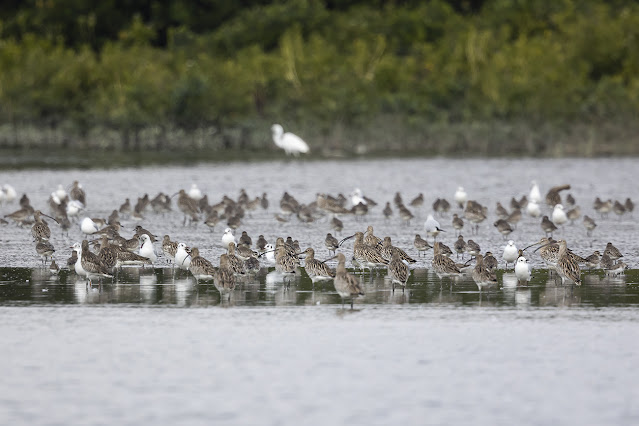After a few days of finding the Tree Pipit, I decided to drop back in to take a look at this rarity and get some better photos. I was there early morning, and was the only one looking for the bird as most birders already twitched the bird through the weekend. There were a lot of buntings feeding along the footpath in the morning, I caught sight of a Yellow-breasted Bunting feeding amongst the numerous Black-faced Buntings, one of the first sign of spring migration underway!
 |
| Yellow-breasted bunting - first for me this spring! |
 |
| Black-faced Bunting - confiding male |
After scanning through two flocks of Olive-backed Pipits, I finally found the Tree Pipit feeding a long the fishponds on its own. It was quite confiding, allowed close approach while feeding on the ground. I enjoyed great views of this rarity for half an hour and left it to continue feeding in peace.
 |
| Tree Pipit - continuing to show well |
Numerous Black-faced Spoonbills were resting on the pond next to the Education Centre, I found two Eurasian Spoonbills within that flock, with one of which moulting into breeding plumage.
 |
| Eurasian Spoonbill and Black-faced Spoonbill |
 |
| Black-faced Spoonbill |
Nothing hugely exciting on the scrape, I scanned for Greater Painted Snipes but only found Common Snipes feeding on the wet mud. A pair of Gadwall stayed on, as well as numerous Falcated Ducks, certainly a species I can ever get bored of!
 |
| Common Snipe |
 |
| Gadwall |
 |
| Falcated Duck - male |
Out at Deep Bay, it is the right season to look for rare gulls, although the two rarities that was a Relict Gull and a Black-legged Kittiwake both only stayed for one day, leaving me empty handed on both outings...Pallas's Gulls are now in full breeding plumage, and a few can often be found amongst the other large gulls.
 |
| Pallas's Gull & Lesser Black-backed Gull (heuglini) |
Deep Bay is about the only place in Hong Kong where we can practice some 'gulling', there are enough large gulls here to occupy a gull enthusiast for a good portion of the day! While our most common species is the Lesser Black-backed Gull (heuglini) or as we locals call them Hueglin's Gull, we try our best to pick out the other two 'species', that is the Vega Gull (vegae) and Vega Gull (mongolicus), these two are sometimes considered separate species, but for now they have been lumped together. Heuglin's Gulls have the darkest mantle of the 'three' species, with bright yellow bills and often yellow legs. Another feature of adult Heuglin's is that they have dark spot on upper mandible. Adult Vega Gull (vegae) should show very heavily spotted neck and often breast, dark iris, red legs and a slightly greenish yellow bill, while 2nd or 3rd cycle birds often got very mottled head and underparts. At least that is the general rule of thumb...Here are a few gulls I felt fits vegae.
 |
| Vega Gull (vegae) & Lesser Black-backed Gull (heuglini) |
 |
| Vega Gull (vegae) |
 |
| Vega Gull (vegae) - likely 3rd year bird |
Vega Gull (mongolicus) are quite different to vegae, adults moult earlier in the year therefore we often see adults with completely white head in in winter months, they also have red legs. Here is one adult that fit best as mongolicus.
 |
| Vega Gull (mongolicus) |
Other than the Black-headed Gulls, another 'black-headed' gull we often find out here is the Saunders's Gull, they moult quite early in the year, therefore most of them are already in full breeding plumage by now. This species is listed as Vulnerable, due to ongoing habitat loss in both its breeding and wintering grounds. Fortunately, we still have a fairly healthy wintering population here in Hong Kong for the time being.
 |
| Saunders's Gull |
A few Caspian Terns now arrived, these large terns often mix in with the gulls, their bright red beaks are hard to miss. Other commonly featured birds on the mudflat are numerous waders, you can find almost all the wader species in Hong Kong out here, from large waders like Curlews to tiny ones like Red-necked Stints. It is still quite early in the year for migrating waders, we should see more of them in coming months. Grey Plovers often venture close to the bird hides and are excellent subject for photos.
 |
| Caspian Tern |
 |
| Grey Plover |
The long staying American Wigeon continues to show on and off, but often extremely far away. Black-capped Kingfishers are often found out here at Deep Bay, they are unfortunately in decline in Hong Kong, I truly hope they will not disappear from Hong Kong completely...Eastern Marsh Harriers often come through to harrass the waders and gulls roosting on the mudflat.
 |
| American Wigeon |
 |
| Black-capped Kingfisher |
 |
| Eastern Marsh Harrier |
Finally, I spent some time photographing this rather confiding Eurasian Wryneck, this is an uncommon winter visitor to Hong Kong, while not rare it is not always easy to get good photographs of this cryptic bird, they can be very hard to spot if they are not on the move.
 |
| Eurasian Wryneck |
More spring migrants should be arriving very soon, certainly looking forward to seeing them!






























Yes, we’re all looking forward to spring migration !
ReplyDelete